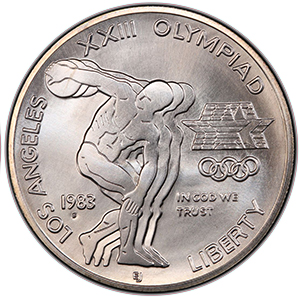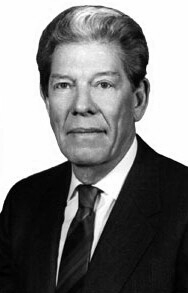He recounted the LAOOC’s belief that to achieve its objectives for the coins, it would need a program that could generate significant sales and that a private marketing organization with experience selling and distributing coins would give it the best chance of doing so. Based on this, the LAOOC considered multiple potential partners and ultimately selected the Coin Group based on its past experience with Olympic coin programs and its domestic and international resources for promotion and distribution. Also important in the Coin Group’s selection was its guarantee of $50 million to the LAOOC and USOC regardless of the ultimate sales volume of the coins.
Mullarkey expressed the Coin Group’s disappointment over the lengthy delay in getting a coin program authorized by Congress and how the delay and reduction in scope had caused it to lower its guarantee to the committees to $30 million. He made clear the Coin Group’s continued interest in the program, however, and reiterated Hammer’s support of St. Germain’s bill over Annunzio’s. It was the Coin Group’s position that Annunzio’s HR6158 could not effectively achieve the objectives of the LAOOC or USOC.
The Coin Group’s coin marketing consultant, J. Donald Gartland III, followed. His remarks were largely a summarization and restatement of arguments previously presented to the committee regarding the need for a large, multi-coin program and for it to be marketed by a private group with relevant experience.
He believed the Coin Group’s previous experience with the Montreal and Moscow coin programs proved that “it [was] essential that there be a variety of coin designs … [and that] the use of multiple designs permits the development of suitable themes and subthemes for various sets and subsets of coins which will enhance the commemorative purpose of the program and build interest and sales of the coins.”
Gartland acknowledged that the number of buyers of commemorative coins was somewhat limited and that it was important for a program to offer a variety of designs to encourage multiple purchases from the same buyers. This, the Coin Group believed, was a fatal flaw in Annunzio’s three-coin proposal – it did not offer the variety needed for success.
It was also his opinion that Annunzio’s proposed 50 million silver dollar coins, split between just two designs, represented too large of a mintage per coin. Without an element of scarcity associated with each design, he argued, it would be very difficult to market the coins – especially in Europe.

Gartland concluded his defense of the Coin Group by noting that while the US Mint was fully capable of producing the desired coins, its ability to effectively market them was questionable. He also believed that Annunzio’s plan to have the coins marketed domestically by the Mint and an outside firm abroad was impractical and most assuredly doomed to fail.
As his colleagues before him, he completed his prepared remarks before the committee by expressing his support for St. Germain’s HR.6058 and by assuring the committee that he, as the person “essentially involved” in the program’s marketing, would conduct it “with the highest level of professionalism and integrity.”
Chairman Annunzio then opened the session to questions and statements from subcommittee members, giving each a five-minute allocation but allowing for multiple rounds, if necessary.
Annunzio kicked things off with a statement of his “unequivocal support” for the private enterprise system, but quickly noted that he was “against a private enterprise system that exploits people and exploits consumers.” Without making a direct link to the Coin Group, he presented an example of such exploitation by recalling a Congressional investigation in which he took part. He had visited US bases around the world to investigate reports of military personnel being subject to exorbitant interest rates on car loans offered by on-base American companies. Annunzio expressed his disbelief that the individuals who were putting their lives on the line in defense of America’s free enterprise system were the very ones being exploited it. It was another calculated move by Annunzio to draw attention to the potentially questionable motives of the Coin Group.
He then segued into a question for Armand Hammer concerning the 1980 Moscow Olympics coin program; Annunzio sought further details about the money US athletes received from the sale of the coins. Hammer responded, “the US Olympic Committee got $800,000 of which the Russians put up $400,000 before the boycott and we, Lazard Freres and ourselves, out of our own pockets, kept up the three-percent payments and we paid $400,000 more.”
Not impressed, Annunzio referred to the revenue generated by the Moscow program as “peanuts” when compared to the $31 million the US Treasury Department believed it could generate for the Olympic committees during just the first four months of its coin sales. Hammer countered by reminding Annunzio that the Coin Group was offering a $30 million guarantee vs. a potential revenue figure that was yet to be realized. He added that the Coin Group believed St. Germain’s proposed program would enable it to generate revenue for the committees in excess of the $30 million guarantee.
Representative Joseph G. Minish (D-NJ) questioned Hammer about the profits realized by the Coin Group on the Moscow program. Hammer was reluctant to answer the question, however, citing their results as proprietary information that could be used by others while developing their bids for the Los Angeles coin program and thus put the Coin Group at a competitive disadvantage.

Representative Chalmers P. Wylie (R-OH) followed Minish and addressed his questions to Thomas Mullarkey. He sought to understand the economic drivers behind the Coin Group’s reduction of its guarantee to the Olympic committees from $50 million to $30 million. He attempted to elicit details about their revised sales forecasts for the coins and to gauge the negative impact caused by the delay in getting a bill approved. Mullarkey would not provide a detailed answer, however, but eventually admitted that the delay had caused the envisioned program to be riskier and less profitable, and that these factors had forced the downward revision in guaranteed funds.
Article Continues on the Following Page(s) ……….




